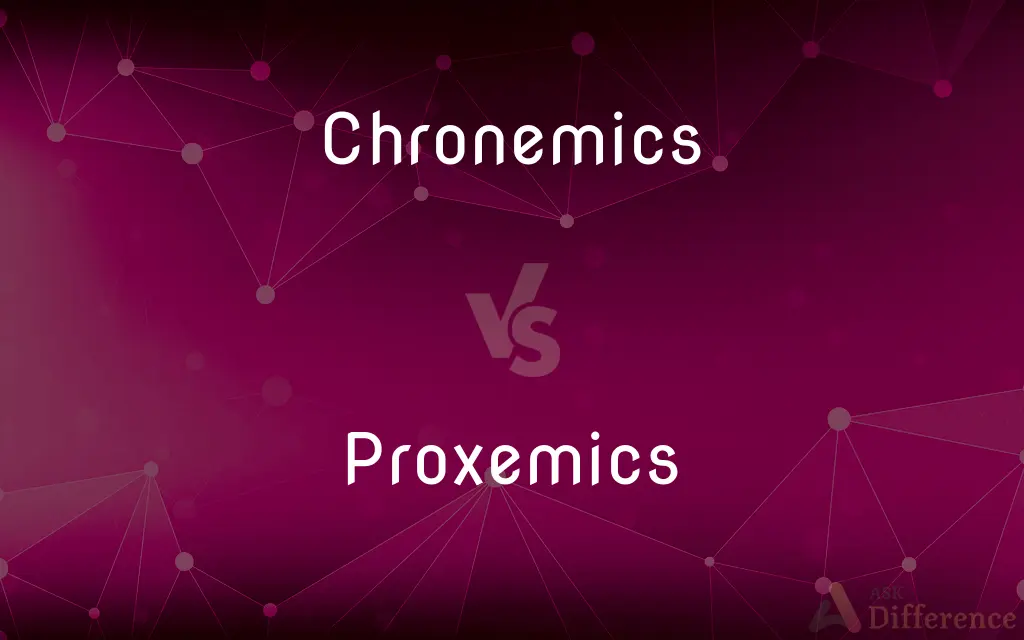Chronemics vs. Proxemics — What's the Difference?
By Tayyaba Rehman — Updated on November 6, 2023
Chronemics studies the use of time in communication, while proxemics examines the use of space.

Difference Between Chronemics and Proxemics
Table of Contents
ADVERTISEMENT
Key Differences
Chronemics is the study of how time affects communication. It considers the timing and frequency of interactions, the punctuality of individuals, and the amount of time that people are willing to spend in various contexts. For example, being late for a meeting can send a message about how one values the other's time.
Proxemics, in contrast, is the study of spatial distances between people as they interact. The amount of space that individuals maintain between each other can communicate levels of intimacy, aggression, or formality. In some cultures, close proximity can signify trust, while in others it may be seen as intrusive.
When discussing chronemics, we often refer to cultural time orientation, such as being polychronic, where people do many things at once and are more flexible with time, or monochronic, where people do one thing at a time and are strict about schedules. This aspect of communication is less visible but significantly impactful.
In the realm of proxemics, the discussion might center on personal space zones, such as intimate, personal, social, and public distances, each with varying ranges depending on cultural norms. Proxemics also goes beyond person-to-person interactions, considering the layout of furniture, architecture, and urban planning.
Understanding chronemics can lead to more effective scheduling, meeting management, and respect for others' time. Awareness of proxemics can improve personal interactions, design of workspaces, and even marketing strategies, as it influences how comfortable people feel in different spaces.
ADVERTISEMENT
Comparison Chart
Field of Study
Time in communication.
Space in communication.
Cultural Aspect
Time orientation (polychronic/monochronic).
Space norms (personal space zones).
Communication Impact
Reflects value of time and timing.
Reflects relational distances and comfort.
Non-Verbal Cue
Timing of messages and responses.
Physical distance in interactions.
Application
Scheduling, punctuality.
Space design, body language.
Compare with Definitions
Chronemics
The study of time's role in communication
The manager's strict adherence to punctuality is an example of chronemics influencing workplace culture.
Proxemics
The study of spatial requirements in communication
Architects use proxemics to design spaces that facilitate comfortable interactions.
Chronemics
The cultural significance of time in communication
A chronemics perspective examines why some cultures are more tolerant of lateness than others.
Proxemics
The impact of spatial environments on behavior
Proxemics research can determine the best layout for an office to promote collaboration.
Chronemics
The use of time to convey messages in interactions
In chronemics, frequently checking a watch during a conversation might indicate impatience.
Proxemics
The use of physical distance to convey social signals
In proxemics, the distance you keep in a conversation can signal your relationship's intimacy level.
Chronemics
Time management in relation to communication
Effective chronemics is crucial for time-sensitive negotiations.
Proxemics
The interpretation of space in nonverbal communication
Standing too close can be a proxemics faux pas in some cultures.
Chronemics
The perception of time in nonverbal communication
Chronemics is at play when a quick response time to emails is interpreted as eagerness.
Proxemics
The analysis of personal space in different cultures
Proxemics helps explain why personal space varies around the world.
Chronemics
Chronemics is the role of time in communication. It is one of several subcategories to emerge from the study of nonverbal communication.
Proxemics
Proxemics is the study of human use of space and the effects that population density has on behaviour, communication, and social interaction.Proxemics is one among several subcategories in the study of nonverbal communication, including haptics (touch), kinesics (body movement), vocalics (paralanguage), and chronemics (structure of time).Edward T. Hall, the cultural anthropologist who coined the term in 1963, defined proxemics as "the interrelated observations and theories of humans use of space as a specialized elaboration of culture". In his foundational work on proxemics, The Hidden Dimension, Hall emphasized the impact of proxemic behavior (the use of space) on interpersonal communication.
Chronemics
The study of the communicative function of time.
Proxemics
The study of the cultural, behavioral, and sociological aspects of spatial distances between individuals.
Proxemics
The study of the effects of the physical distance between people in different cultures and societies.
Proxemics
The study of spatial distances between individuals in different cultures and situations
Common Curiosities
Does digital communication consider chronemics?
Yes, response times and message timing are aspects of chronemics.
How is personal space related to proxemics?
Proxemics studies the cultural and personal variations in personal space.
Why is proxemics important in public speaking?
It helps speakers use space effectively to engage the audience.
How can one improve their understanding of chronemics?
By being aware of and respecting different time-use practices.
Can chronemics differ in professional and personal settings?
Yes, expectations and use of time often vary between these settings.
Can misunderstanding chronemics lead to conflict?
Yes, especially if there's a mismatch in time sensitivity between cultures.
What does chronemics tell us about communication?
It reveals how the use and perception of time impact interaction.
Does proxemics only apply to people?
No, it also applies to the arrangement of objects and environments.
Is proxemics a conscious behavior?
Not always; much of it is ingrained and performed subconsciously.
How does proxemics affect communication in different cultures?
Cultural norms dictate comfortable speaking distances, affecting interactions.
How does technology affect proxemics?
Technology creates new types of spaces and alters our perception of distance.
Are chronemics and proxemics related to each other?
Indirectly, as both are subfields of nonverbal communication and can influence social interaction.
Can chronemics affect business negotiations?
Yes, different attitudes towards time can impact negotiation processes.
How does proxemics relate to body language?
Body language is often adjusted according to the spatial norms of proxemics.
Are there universal rules in chronemics?
No, perceptions of time are culturally relative.
Share Your Discovery

Previous Comparison
Potsherd vs. Potshard
Next Comparison
Zoophile vs. FurryAuthor Spotlight
Written by
Tayyaba RehmanTayyaba Rehman is a distinguished writer, currently serving as a primary contributor to askdifference.com. As a researcher in semantics and etymology, Tayyaba's passion for the complexity of languages and their distinctions has found a perfect home on the platform. Tayyaba delves into the intricacies of language, distinguishing between commonly confused words and phrases, thereby providing clarity for readers worldwide.














































